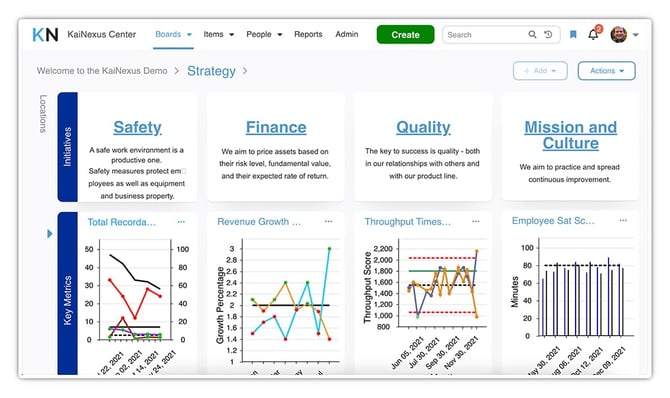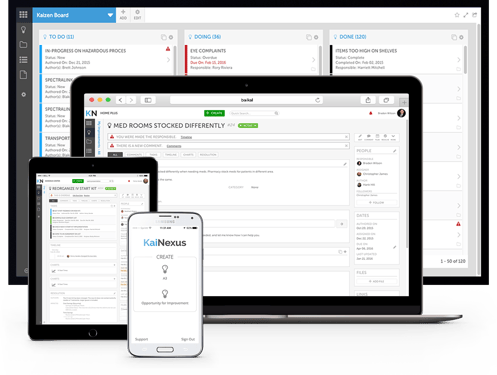 We’ve yet to meet a business leader who believes that every process in the organization is perfect. We all want to get lower costs, better customer satisfaction scores, more efficiency, and new ways of driving revenue. The difference between organizations that achieve these ends, and those that can’t, often comes down to the structure upon which process improvement initiatives are built. Process improvement software offers a number of compelling advantages.
We’ve yet to meet a business leader who believes that every process in the organization is perfect. We all want to get lower costs, better customer satisfaction scores, more efficiency, and new ways of driving revenue. The difference between organizations that achieve these ends, and those that can’t, often comes down to the structure upon which process improvement initiatives are built. Process improvement software offers a number of compelling advantages.
1. Leaders Gain Insight into Improvement Activities
The continuous improvement approach is centered around small, incremental changes. In most cases, these projects don’t require executive-level intervention. Problems with workspace layout, inefficient documents, or haphazard data entry aren’t likely to land on the CEO’s desk. But those are exactly the types of problems that continuous process improvement is designed to resolve. With technology in place, leaders get a view into how the team tackles issues like these. There is great value in knowing what types of problems are uncovered, who is working to fix them, and how quickly those improvement projects are moving toward completion.
2. Goals are Consistent and Aligned Across the Organization
Most leaders go through a strategic planning process, developing a vision for where the organization will be three to five years from now. In order to get there, everyone needs to be moving in unison and working toward the same breakthrough objectives. Process improvement software sets up the structure for leaders to cascade goals from the board room down to the front line. Each person has a clear understanding of how their work relates to the strategic goals, and those same objectives can drive performance evaluations. When everyone is aligned around the most important missions, decision making is easier, and opportunities for improvement are easier to spot.

3. Leaders Can Create a Culture of Improvement
Every organization has a company culture, even if it isn’t intentional. Leaders interested in continuous improvement try to infuse the culture with improvement-centric thinking and help employees develop the willingness to engage. This isn’t easy because culture can’t be forced. It is the sum of all of the cues people receive about what “normal” behavior looks like. Process improvement software serves as a culture dashboard. Leaders can see which people, teams, and departments are out there effecting positive change. They can also identify where additional training, coaching, and encouragement are needed.
4. The Investment Underscores the Importance of Improvement
Most companies have software to manage every other important aspect of the business. Sales is probably run on a CRM, the finance team has an ERP, and there are likely even have multiple tools running HR. That’s because these core business functions are essential and must be well managed and documented. Process improvement work is no different. When leaders invest in software, they send a signal to everyone that this work is essential. A process improvement technology investment gives your team confidence that the organization is willing to put financial resources behind the work and invest in making individuals successful at managing waste reduction and improvement projects.
5. Employee Recognition Becomes Standard
Process improvement requires people to step out of their comfort zone and look at problems in a new way. This can be uncomfortable, especially when the approach is new, and the culture hasn’t been developed yet. The best way to champion the benefits of daily improvement and to get people excited about the possibilities is to recognize the people who get engaged and take risks. The best process improvement systems include success broadcasting to make sure that each improvement is shared far and wide.
6. The Impact of Improvement Can be Calculated

Embracing continuous process improvement will change the principles on which your organization operates and impact the daily work of every member of the team. Therefore, it is crucial that leaders quantify the impact of improvements and show employees, investors, boards, and others that the effort has been worth it. Process management software helps you quantify the results against your organization’s key performance indicators like lower costs, improved customer satisfaction, fewer defects, and increased revenue.
7. You Create One Version of the Truth
Email and spreadsheets are sometimes used as an alternative to process improvement software with disappointing results. Email fine for reminders, but it doesn’t give people one place to go for real-time information that is available to all the players. Spreadsheets are fine for keeping lists, but they are a passive and easily broken source for data. Improvement management software gives everyone on the team one place to go for the latest information. Everyone is on the same page because they are looking at the same data, not some email message or file that may be out of date.
8. Improvement Happens Faster
Process improvement software keeps managers informed about the progress of each project so that they can coach the team and remove obstacles early in each project. Everyone knows when a task is assigned, or a due date is approaching. Without this type of support, projects can languish and never see the finish line.

9. A Knowledge Base Develops
Process improvement technology serves as a repository for all information about opportunities for improvement and implemented projects. Teams can learn from past results and repeat what works and avoid past mistakes. New employees can be on-boarded quickly, and important knowledge isn’t lost when people change roles or leave the company.
10. Change Management is Consistent
Sometimes people get very excited about the idea of improvement and start making changes that they suspect will lead to better results without a formal improvement cycle (PDSA or DMAIC) or proper documentation. That can lead to changes that do more harm than good or improvement that is impossible to calculate. An improvement platform helps solve for this by creating a consistent process for implementing change for the entire organization. Projects are documented and shared. Proven change management techniques can be leveraged to get the best possible outcome.
11. Meetings are More Effective
In many organizations, too much time in meetings is spent on status updates, and too little is devoted to action items. Process improvement software helps make meetings more useful because everyone can get up to speed on the current status of projects before the meeting. People can effectively participate from anywhere because the information is all online and more time can be devoted to discussing challenges and next steps because the details are right at everyone’s fingertips.
These are just a few of the many benefits of applying purpose-built technology to process improvement. Organizations that deploy software designed to support, document, and align improvement efforts gain significant advantages over the competition.



Add a Comment